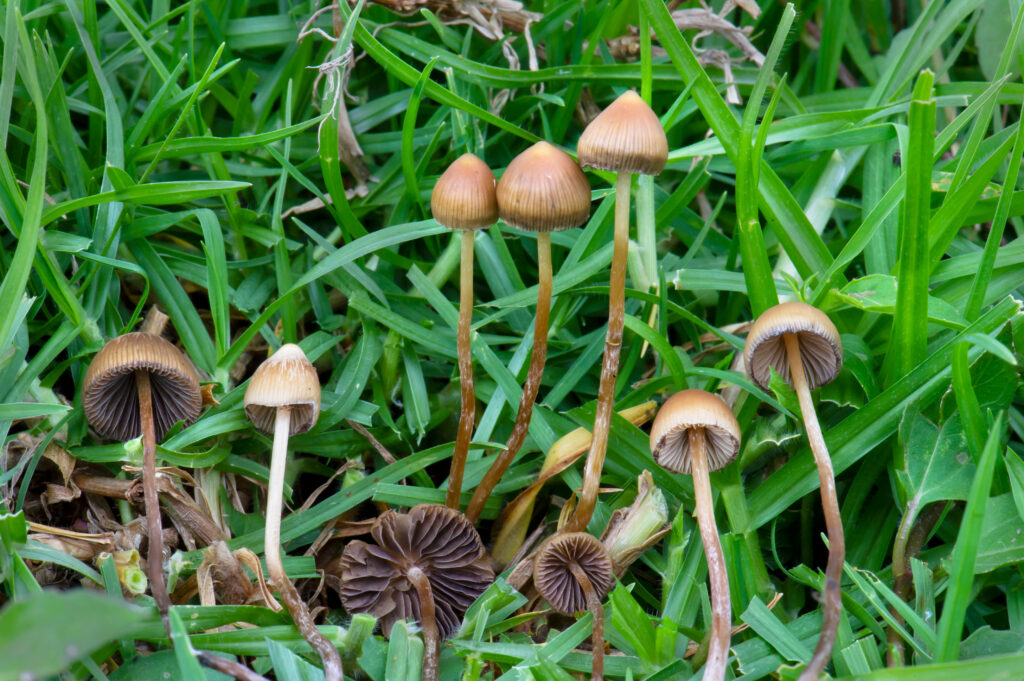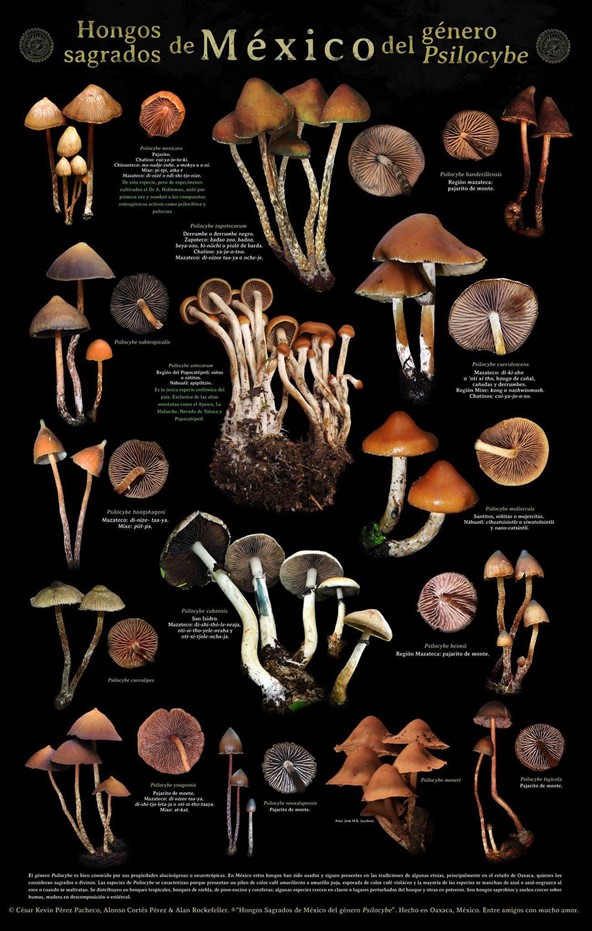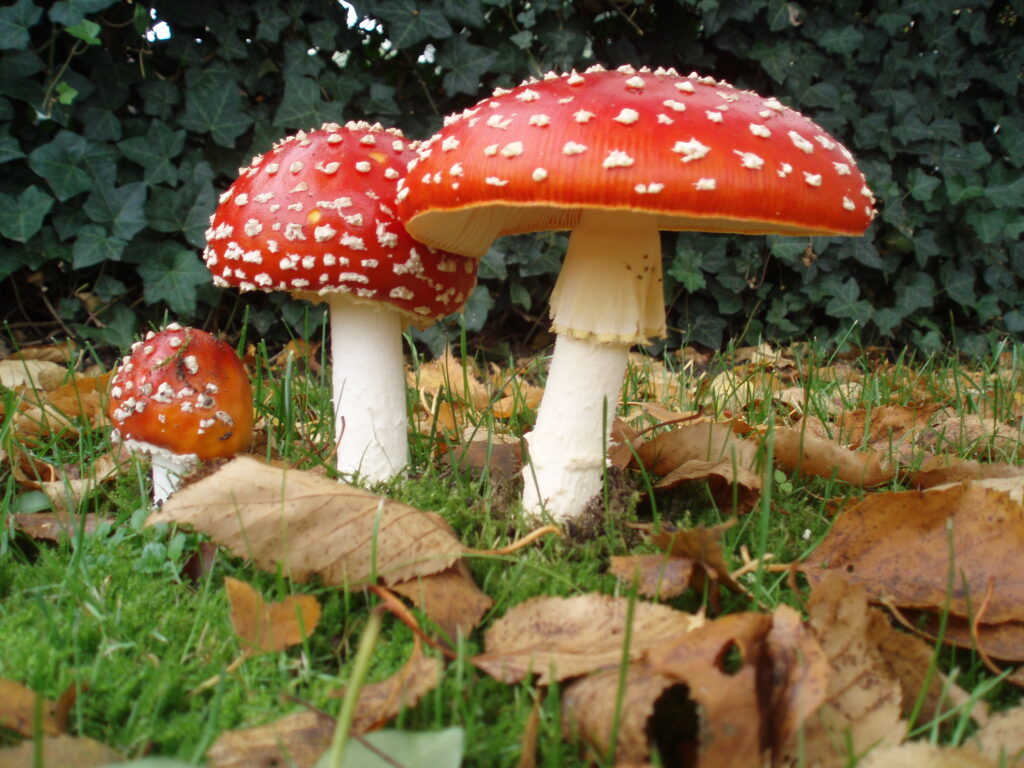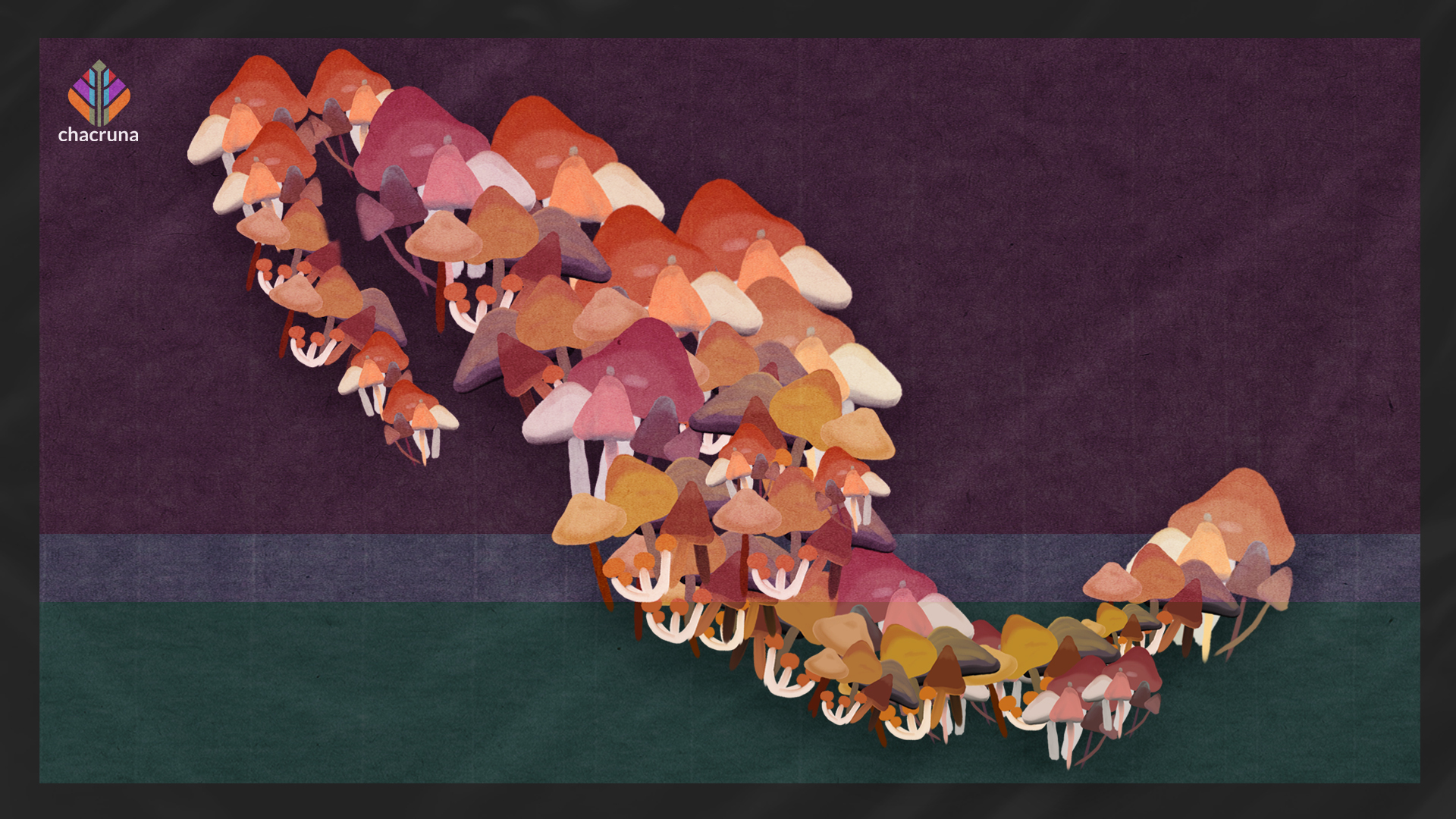Ecology and Biodiversity of Psychedelic Mushrooms in Mexico
Mexico is by far the richest country in psilocybin fungi. In a review article published in 2008, Gastón Guzmán identified 53 psychoactive mushroom species of the genus Psilocybe alone. However, according to researcher Virginia Ramírez-Cruz, who studies fungal taxonomy and phylogeny at the University of Guadalajara, only about 20 are currently recognized as separate species, others appear to be the same species under different names. Her work has been confirmed by recent morphological studies based on type specimens (Cortés-Pérez et al., 2021) or phylogenetic analyses (Ramírez-Cruz et al., 2013), however, not all the synonymous species names have been published yet. Another genus with species containing psychoactive compounds is Panaeolus, such as P. cyanescens (Copelandia cyanescens) and P. subbalteatus, both of which occur in Mexico. According to Guzmán (2008) Panaeolus species do not appear to have been consumed by indigenous peoples, who generally regard them as poisonous. Other genera with psilocybin-containing species are Conocybe, Galerina, Gymnopilus, Inocybe, Pholiotina, and Pluteus, but again they do not seem to have a documented traditional use.
In terms of ecological distribution in Mexico, many hallucinogenic Psilocybe species are found in cloud forests, growing on mountain slopes along the Gulf of Mexico and Pacific Ocean. These regions vary in altitude from between 900 and 3,000 meters above sea level (ASL), and are characterized by very high humidity. Species found there include P. banderillensis, P. heimii, P. fagicola, P. yungensis. Other Psilocybe species are found in coniferous forests, including P. muliercula or P. aztecorum, the latter at elevations up to 4,000 meters ASL, while others are found in tropical meadows (P. cubensis, P. subcubensis) and in tropical rain forests (P. uxpanapensis, P. singerii, P. moserii P. verae-crucis) (Guzmán et al., 2005).

While some psychoactive mushroom species have benefited from human activities and are now widespread all over the world, others are threatened—although we do not currently have enough data to estimate the risk to most species in terms of populations studies and distribution ranges of these mushrooms. One example of a highly successful widespread mushroom species is P. cubensis, which traveled to the Americas from West Africa via cattle farming. It is probably the most common dung-growing mushroom in the tropics. Psilocybe mexicana, P. zapotecorum, and P. caerulescens are also very common in Mexico, the first grows in grassland grazed by animals surrounded by subtropical forests and the other two are typical inside forests (both temperate and subtropical).
On the other hand, certain psychoactive mushrooms are not only endemic to Mexico, but also have highly localized habitat—and are most threatened by human activities and urbanization. An example is P. meridionalis, which has only been collected in a single instance from a subtropical Quercus–Pinus forests of Jalisco. It has never been reported again.
“Mushrooms growing in cloud forests and localized to high elevations are particularly vulnerable to habitat loss and climate change.”
Mushrooms growing in cloud forests and localized to high elevations are particularly vulnerable to habitat loss and climate change. Mountain cloud forests represent less than 1% of Mexico’s total forest area and are severely fragmented. As a result of climate change, it has been predicted that the cloud forests may reduce by 68% in the next 50 years (Ponce-Reyes et al., 2013). Another of Mexico’s rapidly disappearing ecosystems are its tropical rainforests, due to a continuing expansion of cattle ranching and agriculture.
Join us for our next conference!
Ethnomycology
Of the many psychoactive species known in Mexico, only about a dozen have known ceremonial uses. Aside from the hypothesized ancient use of Amanita muscaria (Schultes and Hofmann, 1979), most of Mexico’s sacred mushrooms with a confirmed ethnomycological history belong to the genus Psilocybe (Table 1), with possible exception of Conocybe siligineoides or ya’nte used by the Mazatec people in Oaxaca (Heim, 1956).
Several indigenous groups have a documented traditional ceremonial use of magic mushrooms down to the present day. These are the Nahuatls in the states of Mexico, Morelos, and Puebla; the Matlazincs in the state of Mexico; the Totonacs in Veracruz; and the Mazatecs, Mixes, Zapotecs, and Chatins in Oaxaca (Guzmán, 2008, 2019). There are regional cultural and language differences, and different species of mushrooms are used (Table 1). Traditional use was re-discovered in Mexico in the 1950s among the Mazatecs of Huautla de Jiménez in the state of Oaxaca, owing to María Sabina sharing the mushroom ceremony with Gordon and Valentina Pavlovna Wasson, who published an account of their experience in their book Mushrooms Russia and History (1957). This book and particularly an illustrated article by Gordon in Life magazine that appeared the same year on the Mexican mushroom veladas (sessions) were key in introducing these traditions to a wider audience. The piece described María Sabina’s ceremony, which gave rise to large numbers of people wanting to discover for themselves the mushrooms with visionary powers. This article brought the “little brown mushrooms” from Mexico into the global pharmacopeia of consciousness-expanding substances, but had devastating consequences for María Sabina and her community, resulting from the commercialization of the ceremonies and sacred mushrooms themselves.

“This article brought the “little brown mushrooms” from Mexico into the global pharmacopeia of consciousness-expanding substances, but had devastating consequences for María Sabina and her community, resulting from the commercialization of the ceremonies and sacred mushrooms themselves.”
Curiously, while a lot has been written about the Mazatecs, not much new research is being published about other Indigenous peoples in Mexico who also use sacred mushrooms. What we do know from the ethnomycological work by Wassons, Schultes, and Guzmán is summarised below. First, Catholicism has had a considerable influence on the ceremonies. For example, a Catholic altar is always present, and Catholic prayers in Spanish are used alongside prayers in Indigenous languages. Other commonalities shared across these ceremonial traditions are that they are always held at night and under the guidance of a trained curandero or curandera (healer). Typically, the mushrooms are placed in a gourd, or jicara, and incensed with a tree resin called copal. The mushrooms are always served in pairs (they are said to be “married”), and only a single species is consumed at each ceremony. An exception to this is the Nahuatl of Nevado de Toluca region, where both Cordyceps and Elaphomyces are used in together with Psilocybe (Heim and Wasson, 1958). The dose is usually between 6 and 12 pairs of mushrooms—eating more than that is considered dangerous. The mushrooms are eaten on an empty stomach, and the person(s) undergoing the ceremony are under various restrictions leading up to it, such as abstaining from alcohol and other drugs, medical or otherwise. It is also advised to avoid travel for about a week after the ceremony.
Traditional mushroom ceremonies survived to the present days only in the relatively remote areas high in the mountains. Yet, archaeological evidence confirms sacred mushroom ritual use elsewhere in Mexico (pre-Colombian mushroom use in Mexico and central America deserves a separate article). The likely reason for this is the persecution and eradication of these traditions by the Catholic church during Mexico’s Spanish colonial years. Where sacred mushroom ceremonies persist, they were preserved by a combination of the adoption of syncretic practices, secrecy, and the remoteness of the location.

In Mexico, recreational use of psilocin and psilocybin is forbidden under the “Ley General de Salud” (General Health Law) of 1984, although there are efforts underway to decriminalize its use. Mexico was in fact the first country to protect traditional use of psychedelics by Indigenous peoples—when the UN Convention on Psychotropic Substances, 1971 was ratified and adopted in Mexico in 1975, it specifically included an exemption for the traditional use of peyote and psychedelic mushrooms. Moreover, in 1990 Mexico also ratified the UN’s Indigenous and Tribal Peoples Convention, 1989, which requires governments to work with Indigenous people to safeguard natural resources. In terms of environmental regulation, 33 species of genus Psilocybe, Conocybe siligineoides, and several other fungal species are listed under Norma Oficial Mexicana NOM-059-SEMARNAT-2010. Given that some of the species in this list have worldwide distribution (e.g., Amanita muscaria), and individual species assessments are not available, it is unclear how/why some of the species were included and there are no ecological studies supporting the inclusion of these species. Moreover, the listing is not accompanied by any specific conservation actions.
At the very minimum, ex situ conservation actions should be taken, for example by obtaining germ-plasm collections if the species are indeed threatened. As for the international listing, the IUCN Red List of Threatened Species really lags in terms of fungi assessment. According to the State of the World’s Plants and Fungi Report (2020), of the estimated more than 2.2 million fungal species, only about 148,000 have been described, and a mere 418 of those have been assessed on the Red List, equating to 0.06%. Nevertheless, several Mexican Psilocybe species are listed as endangered (P. neoxalapensis, P. mammillata, P. banderillensis, P. fagicola, P. cordispora) or vulnerable (P. aztecorum).
Table 1. Principal psychedelic mushrooms of Mexico and Indigenous groups that use them (based on Guzmán, 2005; Guzmán et al., 2012; Cortés-Pérez, 2021; IUCN Global Fungal Red List and NOM-059 = LISTA DE ESPECIES EN RIESGO DE LA NORMA OFICIAL MEXICANA NOM-059-SEMARNAT-2010).
| Species | Habitat, location, and endemism | Conservation Status | Indigenous groups documented using psychoactive mushrooms |
| Psilocybe aztecorum, apipiltzin or niño de las aguas in Spanish (“rain water child”) | Grows on decomposing woody debris and in Mexico is found along the ravines in mountainous areas at elevations of 2,000–4,000m in open conifer forests. Country occurrence: Mexico and Canada. | IUCN: Vulnerable NOM-059: A | Nahuatls |
| P. caerulescens, teotlaquilnanácatl, “sacred mushroom that paints or describes,” derrumbe or “landslide” mushrooms. Other names: cañadas, derrumbe de agua, derrumbe negro, hongo de desbarrancadero | Grows on disturbed ground, on muddy soils with wooden debris, has a wide distribution range and low specificity in vegetation type. Country occurrence: Mexico, USA, Panama, Costa Rica, Venezuela, Ecuador, and Brazil. | IUCN: Least concern NOM-059: A | Mazatecs Mixes Nahuatls Totonacs Zapotecs Purepechs (?) |
| P. cordispora chamaquillo, atkad “judge” | Found in mountain cloud forest. Endemic to Mexico | IUCN: Endangered NOM-059: Pr | Mazatecs Mixes Totonacs |
| P. cubensis San Isidro, gold cap | Pan-tropical, the most common mushroom in cultivation. Found on cow (and occasionally horse) dung, sugar cane mulch or rich pasture soil. Found in multiple countries across the world, both in the wild and in cultivation. | Not listed | Chatins Mazatecs Mixes Nahuatls Zapotecs |
| P. fagicola señores principales | Grows in broadleaf forests, e.g., beech. Endemic to Mexico. | IUCN: Endangered NOM-059: A | Nahuatls (?) Totonacs (?) |
| P. hoogshagenii los niños or los chamaquitos (“the little boys”); in Mazatec as pajaritos de monte (“little birds of the woods”) | Found in humus or clayey soils in subtropical coffee plantations. Country occurrence: Mexico, Argentina, Colombia, and Brazil. | NOM-059: A | Mixes Zapotecs |
| P. mexicana teotlaquilnanácatl, “sacred mushroom that paints or describes” or pajaritos, “little birds.” Other names: alcalde, angelito, hongo sagrado, kong, kongk, konk, nize, piule de churis | Grows alone or in small groups among moss along roadsides and trails, humid meadows or cornfields, and particularly in the grassy areas bordering deciduous forests. Common at elevations between 300–550m, rare in lower elevations. Country occurrence: Mexico, Costa Rica, and Guatemala. | NOM-059: A | Chatins Mazatecs Mixes Nahuatls Zapotecs |
| P. muliercula siwatsitsintli or mujercitas (“little women”) | Known to grow in Abies and Pinus forests at elevations of 3,150–3,500 and 2,600–2,800m, respectively. Often found in areas after landslides. Endemic to Mexico. | NOM-059: A | Matlazincs Nahuatls |
| P. subcubensis | Very similar to P. cubensis. Other than by spore size, it is visually undistinguishable from P. cubensis. | Not listed | Chatins Mazatecs Mixes Nahuatls Zapotecs |
| P. yungensis pequeños que brotan, hongo adivinador “divinatory mushroom”, hongo que adormece “soporific mushroom”, or hongo genio “genius mushroom” | Typically grows in clusters or groups on rotting wood (rarely on humus), less frequently solitarily. Often reported from coffee plantations, subtropical, or cloud forests, especially those occurring at elevations between 1,000 and 2,000m. Country occurrence: Mexico, Bolivia, Colombia, Ecuador, Martinique, and China. | NOM-059: A | Mixes |
| P. zapotecorum corona de Cristo “Christ’s crown.” Other names: badaoo, cañadas, derrumbe, derrumbe negro, desbarrancadero, hongo de barrancos, hongo de derrumbes, hongo de la corona de Cristo, hongo de la razón, hongo de las cañadas, hongo santo, piule de barda | Found near rivers, creeks, and ravines, sometimes growing directly from steep mossy ravine walls, also in humid and shadowed places in mesophytic, oak-and-pine, or cloud forests. Country occurrence: Argentina, Brazil, Chile, Colombia, Mexico, Peru, Guatemala, El Salvador, Venezuela, and Ecuador. | NOM-059: A | Chatins Matlazincs Mixes Totonacs Zapotecs |
Acknowledgements: I am grateful to Laura Guzmán-Dávalos and Virginia Ramírez Cruz for their time, valuable information, and comments on this article.

Discover the Indigenous Reciprocity Initiative of the Americas
References
Cortés-Pérez, A., Ramírez-Guillén, F., Guzmán, G., Guzmán-Dávalos, L., Rockefeller, A., & Ramírez-Cruz, V. (2021). Type studies in five species of Psilocybe (Agaricales, Basidiomycota). Nova Hedwigia, 197-221.
Guzmán-Dávalos, L., & Cifuentes, J. (2018). Gastón Guzmán, 26 August 1932–12 January 2016. Mycologia, 110(4), 791-794.
Guzmán, G. (2019). The hallucinogenic mushrooms: diversity, traditions, use and abuse with special reference to the genus Psilocybe. In Fungi from different environments (pp. 256-277). CRC Press.
Guzmán, G. (2008). Hallucinogenic mushrooms in Mexico: an overview. Economic Botany, 62(3), 404-412.
Guzmán, G. (2005). Species diversity in the genus Psilocybe (Basidiomycotina, Agaricales, Strophariaceae) of world mycobiota, with special attention to hallucinogenic properties. International Journal of Medicinal Mushrooms, 7(1/2), 305.
Guzmán, G., Allen, J. W., & Gartz, J. (1998). A worldwide geographical distribution of the neurotropic fungi, an analysis and discussion. Ann. Mus. Civ. Rovereto, 14, 189-280.
Guzmán, G. (1959). Sinopsis de los conocimientos sobre los hongos alucinógenos mexicanos. Botanical Sciences, (24), 14-34.
Haro-Luna, M. X., GuzmánDávalos, L., & Ruan-Soto, F. (2020). Mycophilic degree among the Wixaritari and mestizos in Villa Guerrero, Jalisco, Mexico. Ethnobiology and Conservation, 9(6), 1-18.
Heim, R. (1956). Note sur des Champignons divinatoires utilisés dans les rites des Indiens Mazatèques. Journal d’agriculture traditionnelle et de botanique appliquée, 3(5), 320-325.
Ponce‐Reyes, R., Nicholson, E., Baxter, P. W., Fuller, R. A., & Possingham, H. (2013). Extinction risk in cloud forest fragments under climate change and habitat loss. Diversity and Distributions, 19(5-6), 518-529.
Ramírez-Cruz, V., Guzmán, G., Villalobos-Arámbula, A. R., Rodríguez, A., Matheny, P. B., Sánchez-García, M., & Guzmán-Dávalos, L. (2013). Phylogenetic inference and trait evolution of the psychedelic mushroom genus Psilocybe sensu lato (Agaricales). Botany, 91(9), 573-591.
Schultes, R. E., & Hofmann, A. (1979). Plants of the gods: origins of hallucinogenic use. New York.
Art by Mariom Luna.
Take a minute to browse our stock:
Did you enjoy reading this article?
Please support Chacruna's work by donating to us. We are an independent organization and we offer free education and advocacy for psychedelic plant medicines. We are a team of dedicated volunteers!
Can you help Chacruna advance cultural understanding around these substances?















